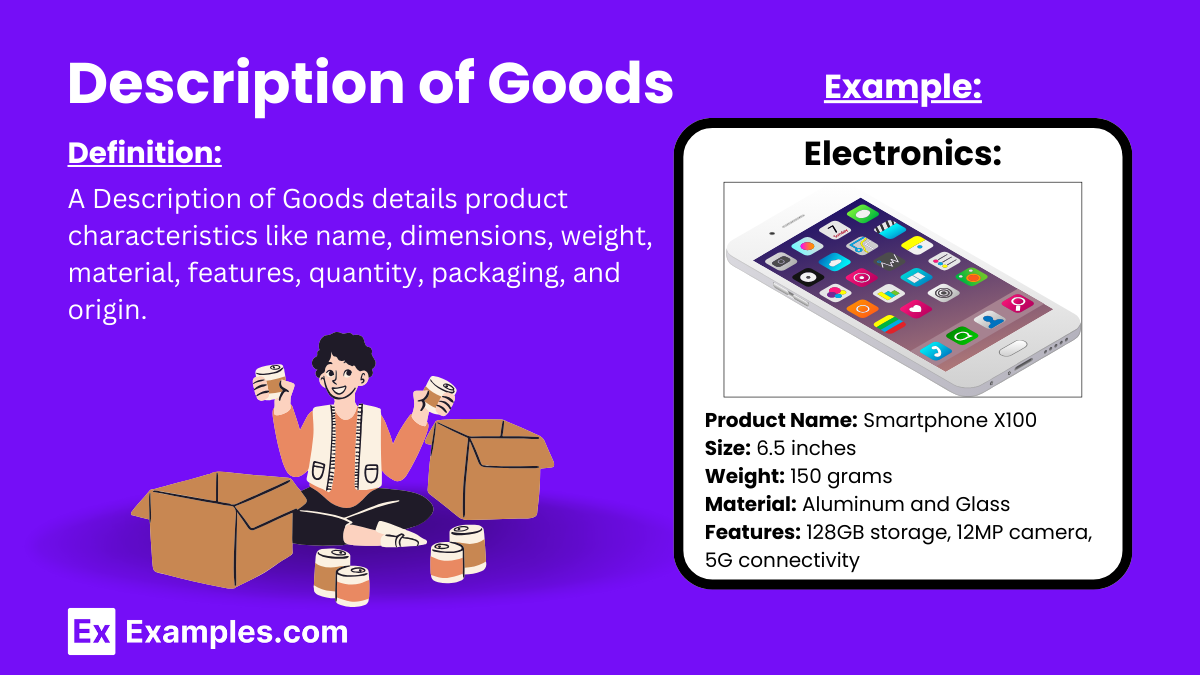25+ Description of Goods Examples
When a business or company creates a product, service, or commodity to sell and supply to the public, they call these things goods. When trying to market their goods to the public they will create a personal brand that will appeal to their target market or audience. The business or company will use their personal branding and description of their goods to try to entice their customers.
What is a Description of Goods?
A Description of Goods details the characteristics, quality, and quantity of products being sold or shipped. It includes information such as product name, size, weight, material, and any unique features. This description is essential for accurate billing, inventory management, and compliance with shipping regulations.
Description of Goods Examples
1. Electronics:
Product Name: Smartphone X100
Size: 6.5 inches
Weight: 150 grams
Material: Aluminum and Glass
Features: 128GB storage, 12MP camera, 5G connectivity
2. Apparel:
Product Name: Men’s T-Shirt
Size: Medium
Weight: 200 grams
Material: 100% Cotton
Features: Crew neck, short sleeves, blue color
3. Furniture:
Product Name: Wooden Dining Table
Dimensions: 72 x 36 x 30 inches
Weight: 50 kg
Material: Oak Wood
Features: Seats 6 people, natural finish
4. Books:
Title: “The Great Gatsby”
Author: F. Scott Fitzgerald
Pages: 180
Weight: 300 grams
Features: Hardcover, includes original illustrations
5. Groceries:
Product Name: Organic Apples
Quantity: 1 kg
Weight: 1 kg
Material: Fresh produce
Features: USDA certified organic, non-GMO
6. Automotive:
Product Name: Car Battery
Size: 12V, 60Ah
Weight: 15 kg
Material: Lead-acid
Features: Maintenance-free, high cold cranking amps
7. Toys:
Product Name: LEGO Building Set
Pieces: 500
Weight: 1.5 kg
Material: Plastic
Features: Includes minifigures, recommended for ages 8+
8. Beauty Products:
Product Name: Moisturizing Lotion
Volume: 200 ml
Weight: 220 grams
Material: Natural ingredients
Features: Hypoallergenic, suitable for all skin types
9. Kitchen Appliances:
Product Name: Electric Blender
Power: 700 watts
Weight: 2.5 kg
Material: Stainless steel and plastic
Features: 5-speed settings, 1.5-liter capacity, detachable blades
10. Sporting Goods:
Product Name: Yoga Mat
Size: 72 x 24 inches
Weight: 1 kg
Material: Eco-friendly PVC
Features: Non-slip surface, 6mm thickness, available in various colors
Description of Goods Examples in Shipping
1. Electronics:
Product Name: Smartwatch X500
Dimensions: 1.5 x 1.5 x 0.4 inches
Weight: 50 grams
Material: Stainless Steel and Silicone
Features: Heart rate monitor, GPS, 32GB storage
2. Apparel:
Product Name: Women’s Yoga Pants
Size: Medium
Weight: 300 grams
Material: Spandex and Nylon
Features: High-waisted, moisture-wicking, black color
3. Furniture:
Product Name: Bookshelf
Dimensions: 60 x 30 x 12 inches
Weight: 20 kg
Material: Solid Pine Wood
Features: 5 shelves, natural finish, easy assembly
4. Books:
Title: “1984”
Author: George Orwell
Pages: 328
Weight: 350 grams
Features: Hardcover, includes a foreword by the author
5. Groceries:
Product Name: Organic Almonds
Quantity: 2 kg
Weight: 2 kg
Material: Nuts
Features: Raw, unsalted, USDA certified organic
Description of Goods Examples for Business
1. Office Supplies:
Product Name: Laser Printer
Model: HP LaserJet Pro M404dn
Dimensions: 15 x 14 x 8.5 inches
Weight: 8.22 kg
Material: Plastic and Metal
Features: Duplex printing, 40 ppm speed, Ethernet connectivity
2. Office Furniture:
Product Name: Ergonomic Office Chair
Model: Herman Miller Aeron
Dimensions: 27 x 27 x 41 inches
Weight: 20 kg
Material: Mesh and Aluminum
Features: Adjustable lumbar support, tilt limiter, breathable mesh
3. Industrial Equipment:
Product Name: CNC Machine
Model: Haas VF-2
Dimensions: 120 x 80 x 100 inches
Weight: 3,629 kg
Material: Steel
Features: 30 hp, 8100 rpm, 20-pocket carousel
4. Business Technology:
Product Name: Server
Model: Dell PowerEdge R740
Dimensions: 3.4 x 18.9 x 29 inches
Weight: 27 kg
Material: Metal
Features: Dual Intel Xeon processors, 256GB RAM, RAID storage
5. Marketing Materials:
Product Name: Brochures
Quantity: 1000 pieces
Dimensions: 8.5 x 11 inches
Weight: 2 kg
Material: Glossy Paper
Features: Full-color printing, trifold, customizable design
Description of Goods Examples for Students
1. Stationery:
Product Name: Notebook
Size: A4
Weight: 300 grams
Material: Recycled Paper
Features: 200 pages, ruled, spiral-bound
2. Textbooks:
Title: “Introduction to Biology”
Author: Dr. Jane Smith
Pages: 500
Weight: 1.2 kg
Features: Hardcover, includes illustrations and diagrams, latest edition
3. Electronics:
Product Name: Graphing Calculator
Model: TI-84 Plus
Dimensions: 7.5 x 3.3 x 1 inches
Weight: 400 grams
Material: Plastic
Features: High-resolution display, preloaded apps, rechargeable battery
4. Art Supplies:
Product Name: Acrylic Paint Set
Quantity: 24 tubes
Weight: 1 kg
Material: Non-toxic Acrylic
Features: Various colors, quick-drying, includes brushes
5. Backpacks:
Product Name: School Backpack
Size: 18 x 12 x 6 inches
Weight: 600 grams
Material: Polyester
Features: Padded straps, multiple compartments, water-resistant
More Description of Goods Samples & Examples
1. Description of Goods
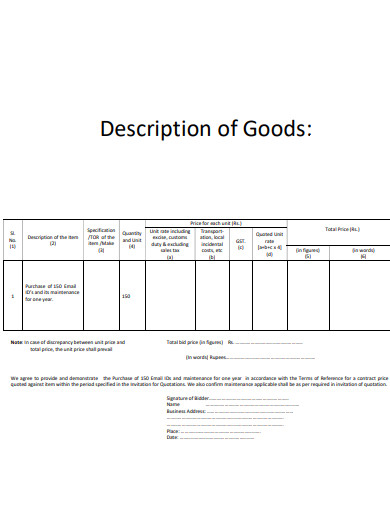
brlps.in
2. Description of Certain Goods Example
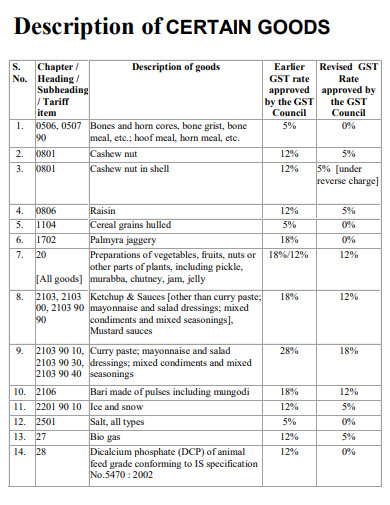
lexcomply.com
3. Description of Goods Taxable Example
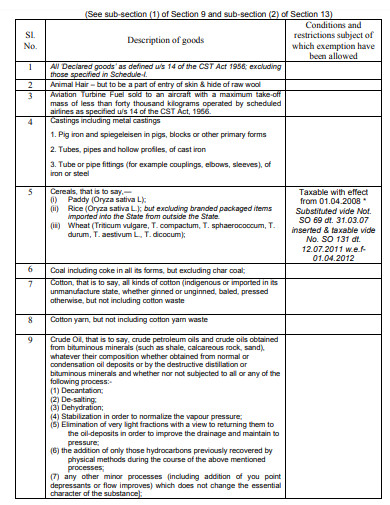
ctax.jharkhand.gov.in
4. Description of Port Goods Example
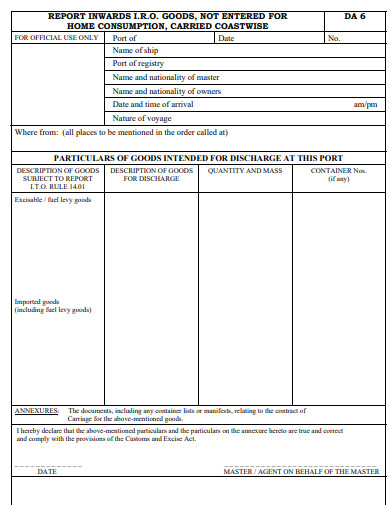
sars.gov.za
5. Description of Goods And Services Example
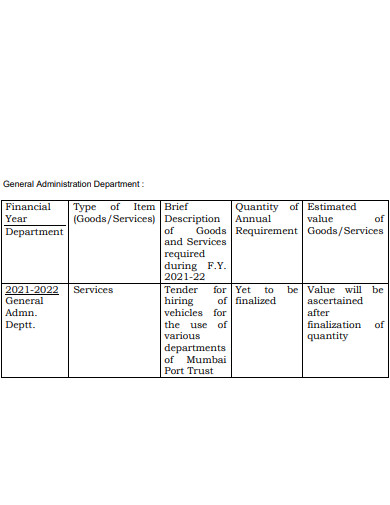
mumbaiport.gov.in
6. Sample Description of Goods Example
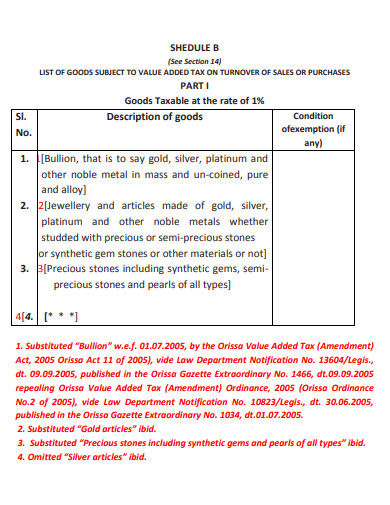
web.odishatax.gov.in
7. Brief Description of Goods Example

customs.go.jp
8. Blank Description of Goods Example
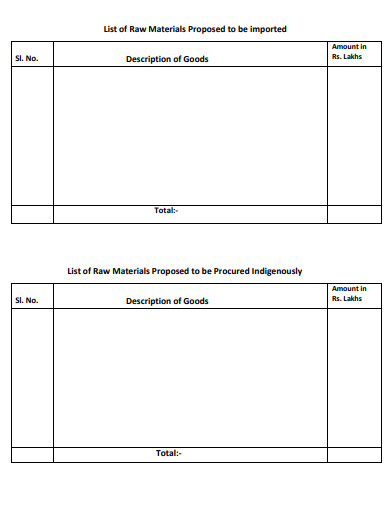
bengaluru.stpi.in
9. List Description of Goods Example
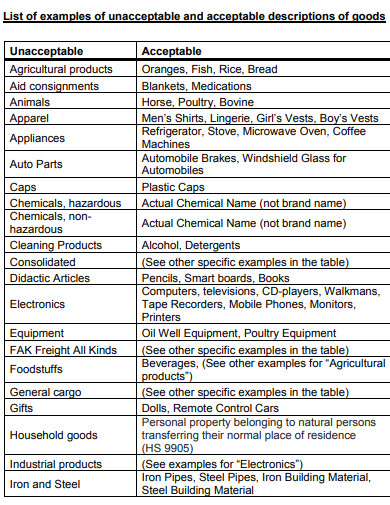
hapag-lloyd.com
10. Import Description of Goods Example
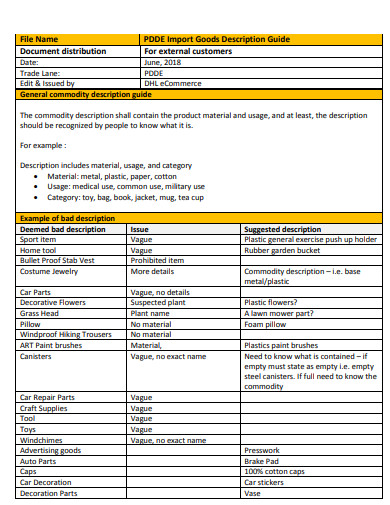
dhl.com
11. Description of Goods Examples
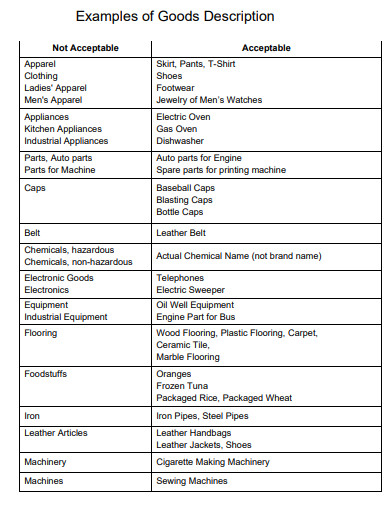
ups.com
12. Description of Goods Template
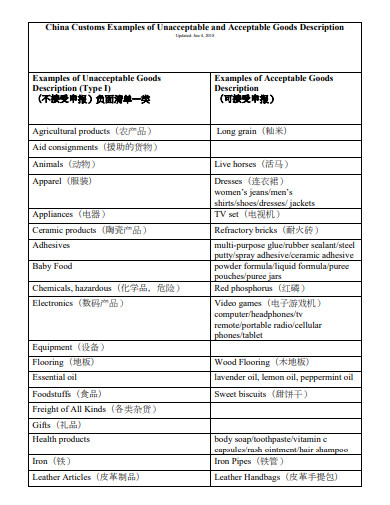
polaraircargo.com
13. Description of Dangerous Goods Example
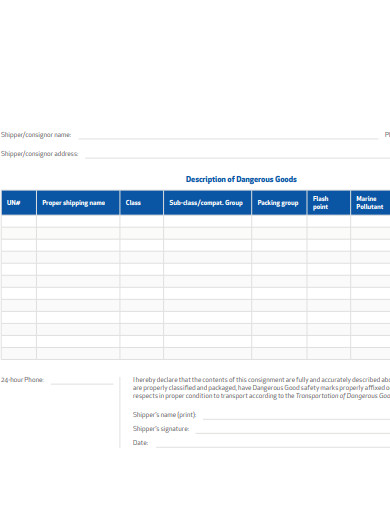
marineatlantic.ca
14. Simple Description of Goods Example
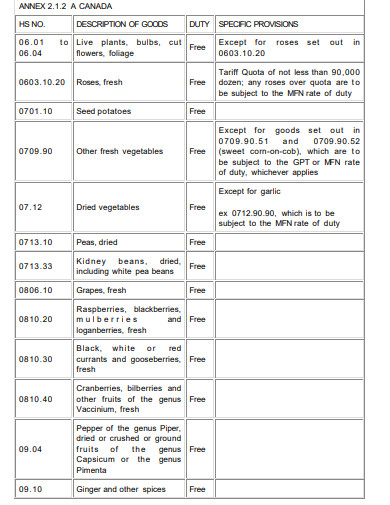
wits.worldbank.org
15. Printable Description of Goods Example

mumbaicustomszone1.gov.in
How to Provide a Description for Goods for a Shipment?
Writing a description for goods for a shipment involves detailing specific characteristics of the products being shipped. Here are the steps to create an effective and comprehensive description:
1. Identify the Product
- Clearly state the product name and model.
Example: Product Name: Laptop Model Z200
2. Provide Dimensions and Weight
- Include the size (length, width, height) and the weight of the product.
Example: Dimensions: 14 x 9 x 0.7 inches, Weight: 1.8 kg
3. Specify the Material
- Mention the main materials used in the product.
Example: Material: Aluminum and Plastic
4. Highlight Key Features
- List important features or functionalities that distinguish the product.
Example: Features: 256GB SSD, 8GB RAM, 13-hour battery life
5. Quantity
- Indicate the quantity of the items being shipped.
Example: Quantity: 50 units
6. Packaging Details
- Describe the packaging type and any special instructions for handling.
Example: Packaging: Individually boxed, Fragile – Handle with care
7. HS Code (Harmonized System Code)
- Include the HS Code for customs classification.
Example: HS Code: 8471.30
8. Country of Origin
- State where the product was manufactured.
Example: Country of Origin: China
Why is a detailed description of goods important?
A detailed description ensures accurate billing, inventory management, and compliance with shipping and customs regulations.
What should be included in a goods description?
Include product name, dimensions, weight, material, features, quantity, packaging details, HS code, and country of origin.
How can a goods description affect customs clearance?
Accurate descriptions prevent delays, fines, and rejections during customs clearance by meeting regulatory requirements.
Can I use abbreviations in a goods description?
Use standard industry abbreviations, but avoid uncommon ones to ensure clarity and understanding.
How specific should the material description be?
Be precise and detailed, especially if the material affects the product’s usage or customs classification.
Is it necessary to include the HS code?
Yes, the HS code is crucial for customs classification and determining duties and taxes.
How do I describe mixed goods in one shipment?
List each item separately with its specific details to avoid confusion and ensure accurate processing.
Should I include the product’s intended use?
Include the intended use if it clarifies the product’s features or is required for customs or shipping.
What are common mistakes to avoid in goods descriptions?
Avoid vague terms, missing details, incorrect dimensions, and using unfamiliar abbreviations.
How often should I update goods descriptions?
Update descriptions whenever there are changes in product specifications, packaging, or regulations.



